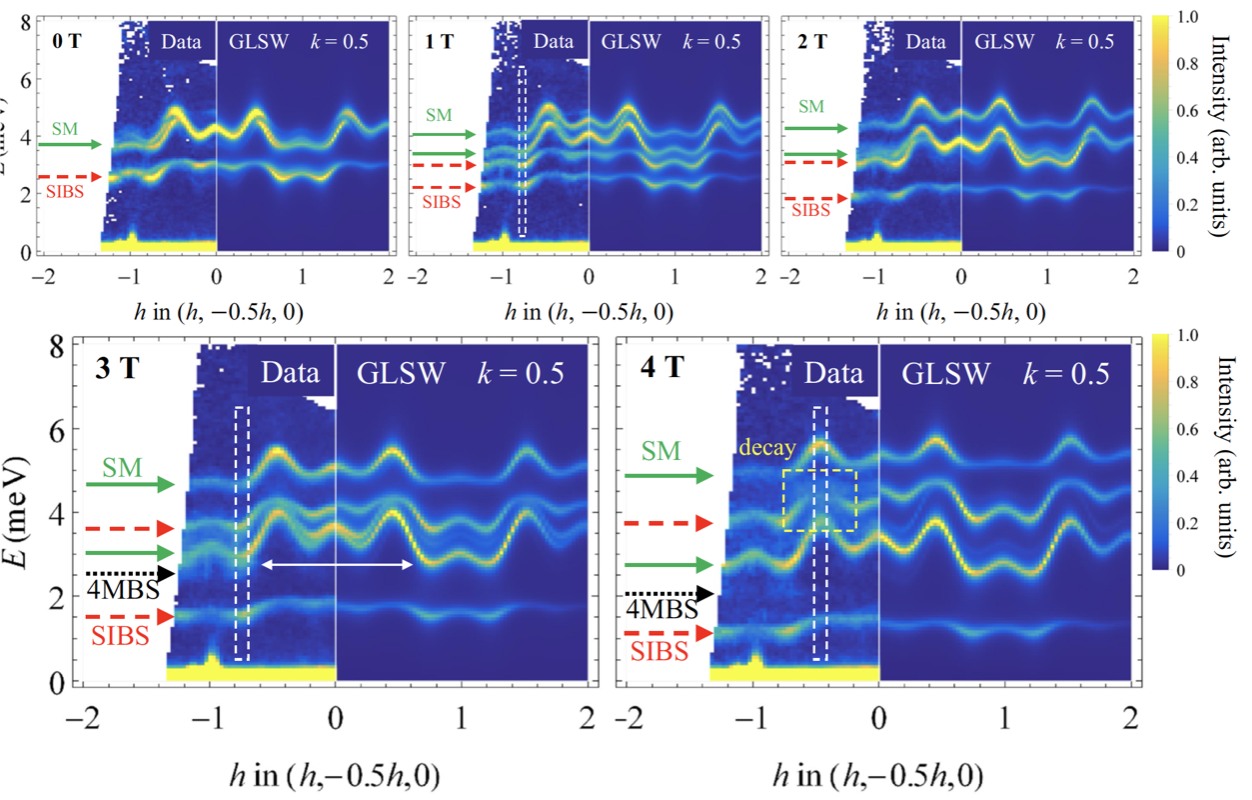PARADIM Highlight #82—External User Project (2023)
M. Mourigal (Georgia Tech), Cristian D. Batista (Oak Ridge National Laboratory)
The concept of quasiparticles is central to understanding and predicting the properties of condensed matter. For example, magnons describe the excitations of fully-ordered magnetic systems. Interactions between magnons can yield to spontaneous decay into multi-magnon states, resulting in incoherent excitation bands. Although magnon instabilities are expected for a broad class of models, their experimental observation is rare and so far, limited to a handful of examples.

Figure 1:: Momentum and energy-resolved neutron scattering spectra of FeI2 at 1.8 K and applied magnetic fields (Data, 0 – 4Tesla) compared to prediction (GLSW—generalized linear spin wave). SM—single magnon, SIBS—single ion-bound states, 4MBS—4 magnon-bound state.
Here, users from Georgia Tech continue their work on single crystals of iron iodide (FeI2) grown by them at the PARADIM Bulk Crystal Facility. In collaboration with Oak Ridge National Lab, they demonstrate that strong quantum interactions exist between three flavors of quasiparticles in the uniaxial spin-one magnet FeI2 through neutron scattering measurements in a transverse magnetic field.
The figure shows a comparison between experiment and simulation for various applied magnetic fields—labeled Data and GLSW respectively—demonstrating the fidelity to which experimental data enables models of magnetic properties to be constructed.
Condensed matter materials systems enable the creation of artificial vacuums in which excitations behave as a plethora of elementary particles, even if those particles are not known to exist outside of such a material. Magnons are the ubiquitous elementary quasiparticle to describe the excitations of fully-ordered magnetic systems, but their interactions have historically been nearly impossible to study. Here, we demonstrate that strong quantum interactions exist between three flavors of elementary quasiparticles in the uniaxial spin-one magnet FeI2. Using neutron scattering in an applied magnetic field, we observe spontaneous decay between conventional and heavy magnons and the recombination of these quasiparticles into a super-heavy bound-state. Akin to other contemporary problems in quantum materials, the microscopic origin for unusual physics in FeI2 is the quasi-flat nature of excitation bands and the presence of Kitaev anisotropic magnetic exchange interactions.
Interactions between particles is the fundamental ingredient giving rise to virtually all useable materials properties and functionality, as well as being relevant for a fundamental understanding of the universe. Quasiparticles, which themselves emerge due to elementary interactions, can display an even richer plethora of interactions, but these are typically difficult to study. Leveraging cm3-scale single crystals grown at PARADIM, here strong and quantum interactions between magnetic quasiparticles is measured and quantified through modeling of the experimental data.
Final step of crystal growth was done in PARADIM’s Ultrahigh Temperature Midscale Induction Bridgman/CZ Furnace. The growth yielded a large boule from which a 4.53 g high-quality crystal was extracted with clear c-axis facet.
The work was initialized by Martin Mourigal of the Georgia Institute of Technology and involved PARADIM staff as well as collaborators at the Oak Ridge National Laboratory.
X. Bai, S.-S. Zhang, H. Zhang, Z. Dun, W.A. Phelan, V.O. Garlea, M. Mourigal, and C.D. Batista, "Instabilities of Heavy Magnons in an Anisotropic Magnet," Nat. Commun. 14, 4199 (2023). DOI: 10.1038/s41467-023-39940-1
We thank Tyrel McQueen for his help with crystal growth at PARADIM. The work of X.B., Z.L.D., and M.M. at Georgia Tech was supported by the U.S. Department of Energy, Office of Science, Basic Energy Sciences, Materials Sciences and Engineering Division under award DE-SC-0018660. The work of H.Z. at the Oak Ridge National Laboratory was supported by the U.S. Department of Energy, Office of Science, Basic Energy Sciences, Materials Sciences and Engineering Division. The work of S.-S.Z. and C.D.B. at the University of Tennessee was supported by the Lincoln Chair of Excellence in Physics. Growth of FeI2 crystals was supported by the National Science Foundation’s PARADIM (Platform for the Accelerated Realization, Analysis, and Discovery of Interface Materials) under Cooperative Agreement No. DMR-1539918. Some of this work were performed in part at the Materials Characterization Facility at Georgia Tech that is jointly supported by the GT Institute for Materials and the Institute for Electronics and Nanotechnology, which is a member of the National Nanotechnology Coordinated Infrastructure supported by the National Science Foundation under Grant No. ECCS-2025462. This research used resources at the High Flux Isotope Reactor and Spallation Neutron Source, a DOE Office of Science User Facility operated by the Oak Ridge National Laboratory.







